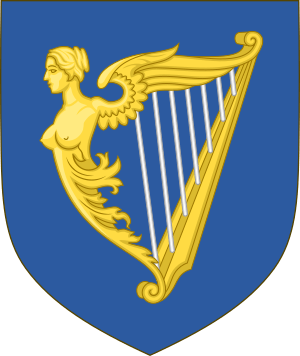Irish Parliamentary Party facts for kids
Quick facts for kids
Irish Parliamentary Party
|
|
|---|---|
|
The Irish harp, along with the coat of arms of the provinces of Ireland, played a prominent role in IPP literature.
|
|
| Founded | 1874 |
| Dissolved | 1922 |
| Preceded by | Home Rule League |
| Succeeded by | Nationalist Party NI |
| Ideology | Irish nationalism Home Rule |
| Colours | Green |
The Irish Parliamentary Party (IPP), also called the Irish Party or the Home Rule Party, was a political group formed in 1874. Isaac Butt started it. He was the leader of the Nationalist Party at the time. The IPP took the place of the Home Rule League.
This party was for Irish nationalist Members of Parliament (MPs). These MPs were elected to the House of Commons in Westminster, which is in the United Kingdom of Great Britain and Ireland. The party existed until 1918.
The main goals of the IPP were two things:
- To get legislative independence for Ireland. This meant Ireland would make its own laws.
- To change how land was owned in Ireland. This was called land reform.
The IPP worked to achieve self-government for Ireland. They did this through three important plans called Irish Home Rule bills.
What Was Home Rule?
In 1886, the Irish Parliamentary Party helped convince British Prime Minister, William Gladstone, to announce a Home Rule bill. This bill was a big deal. It would have allowed Ireland to govern itself. Ireland would have become a British colony but with its own parliament. This meant Ireland would not have representatives in the British Parliament anymore. However, this first bill did not pass.
Later Home Rule Attempts
Other Home Rule bills were suggested later on. These new bills were a bit different. They would have allowed Ireland to keep its representatives in the British Parliament. But none of these bills fully succeeded either.
One bill was passed in 1914. But it was stopped because of the First World War. Another bill was made into law in 1920. However, it failed because of an Irish rebellion.
After these attempts, Ireland got its own independent country called the Irish Free State. This new state included most of the island. Also, a part of Ireland called Northern Ireland was created. It included six counties of Ulster and stayed part of the United Kingdom.
Images for kids
-
Charles Stewart Parnell, an important leader of the IPP
See also
 In Spanish: Partido Parlamentario Irlandés para niños
In Spanish: Partido Parlamentario Irlandés para niños




